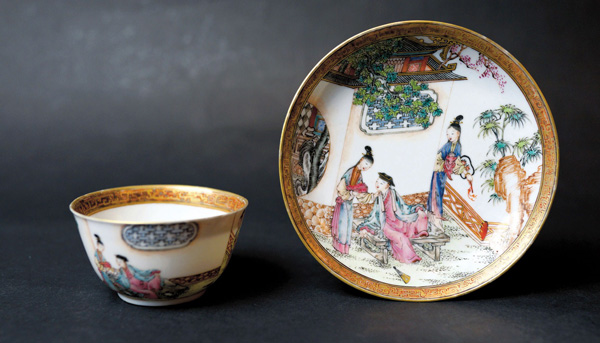 |
|
This Qing Dynasty overglaze porcelain, exported to Britain, features a scene from Romance of the West Chamber.
|
A naked man and woman are making love lying under a willow tree. Their hair is down and they are bulkier than ordinary Chinese. The scene is from a Chinese blue-and-white porcelain plate, with a cup with the same theme, made and exported in the 16th century.
The porcelain was specially commissioned for foreigners, called chu kou ci (出口瓷), but since the craftsmen had never seen a foreigner before, the figures are animalistic, almost savage.
Much of the outside world’s early knowledge of China was based on such fine porcelains.
China has been exporting ceramics since the Han Dynasty (206 BC-AD 220), but exported porcelain ramped up in the early part of the Qing Dynasty (1644-1911) when Emperor Kangxi (1654-1722) lifted a ban on maritime trading. It was estimated by the Dutch East India Company that about 3 million pieces of chinaware reached Europe every year during his reign.
Before the 17th century, most Europeans were able to make only mugs and other rudimentary items from glazed pottery which proved to be fragile and easily shattered. So when they discovered the much stronger Chinese ceramics, they placed large orders.
“The craft skills of making Chinese porcelain were incomparable, so that no other country could produce porcelain ware of the same quality,” says Low Cheong Sin, a veteran Shanghai-based Malaysian collector of exported Chinese porcelain.
“The other secret of china-making was that you couldn’t find the same material in other countries,” Low explains. China clay can be fired at a very high temperature so that it turns whiter and harder.
Fine exported chinaware was a sign of luxury and was in demand by aristocrats all over the continent. They were called “white gold” because 50 grams of the finest Chinese porcelain could be traded for 50 grams of gold.
Now Chinese have started collecting these exported porcelains, which, when they were produced, were specially commissioned for the foreign market and not available domestically. These exported objects have reached such a high status of luxury in their country of origin that the finest small “famille rose” cups have been sold at auction for as much as 500,000 yuan (US$82,379).
Famille rose is “the desirable French ‘rose family’ group of Chinese porcelain wares characterized by decoration painted in opaque overglaze rose colors,” according to Encyclopedia Britannica.
We recommend:
